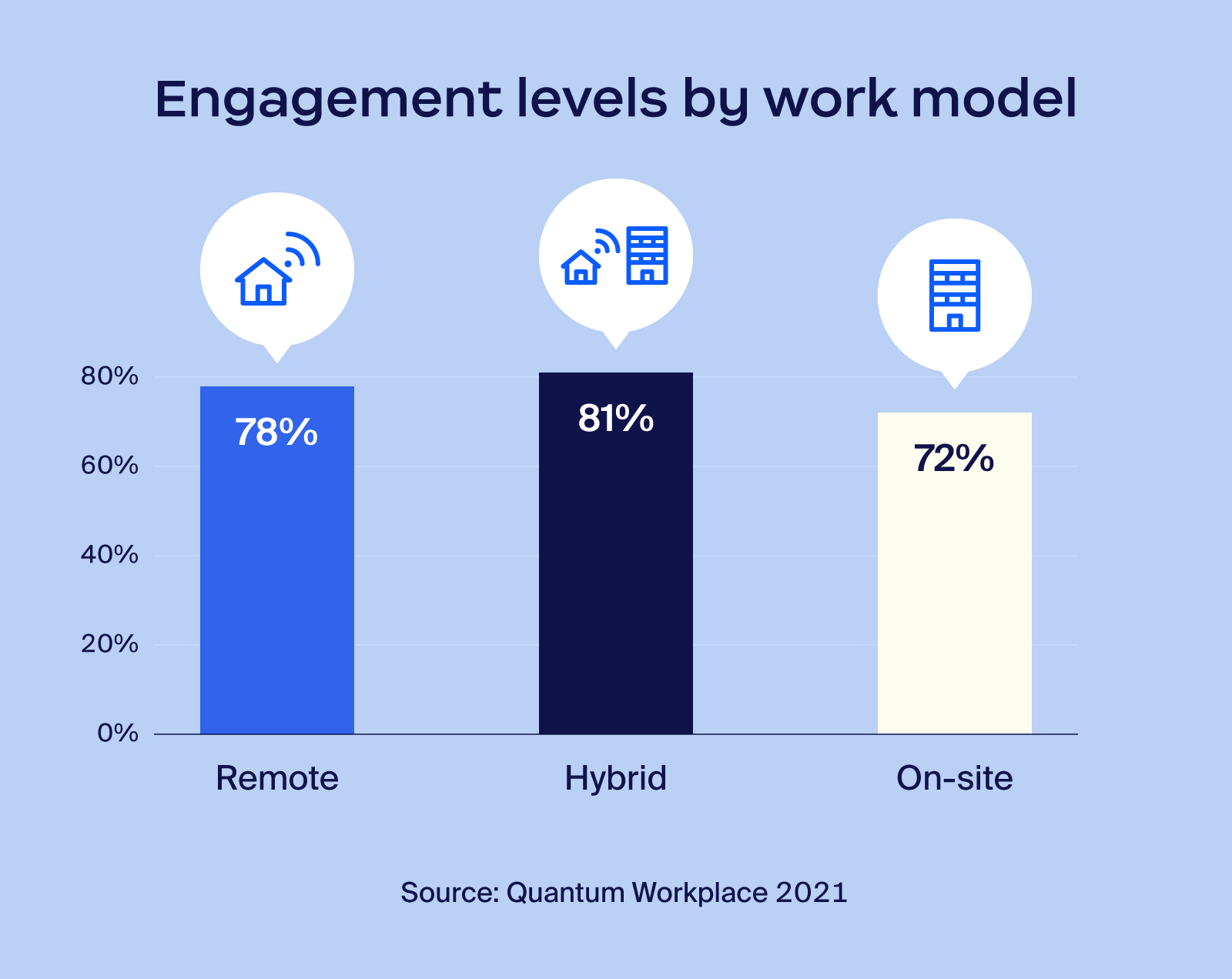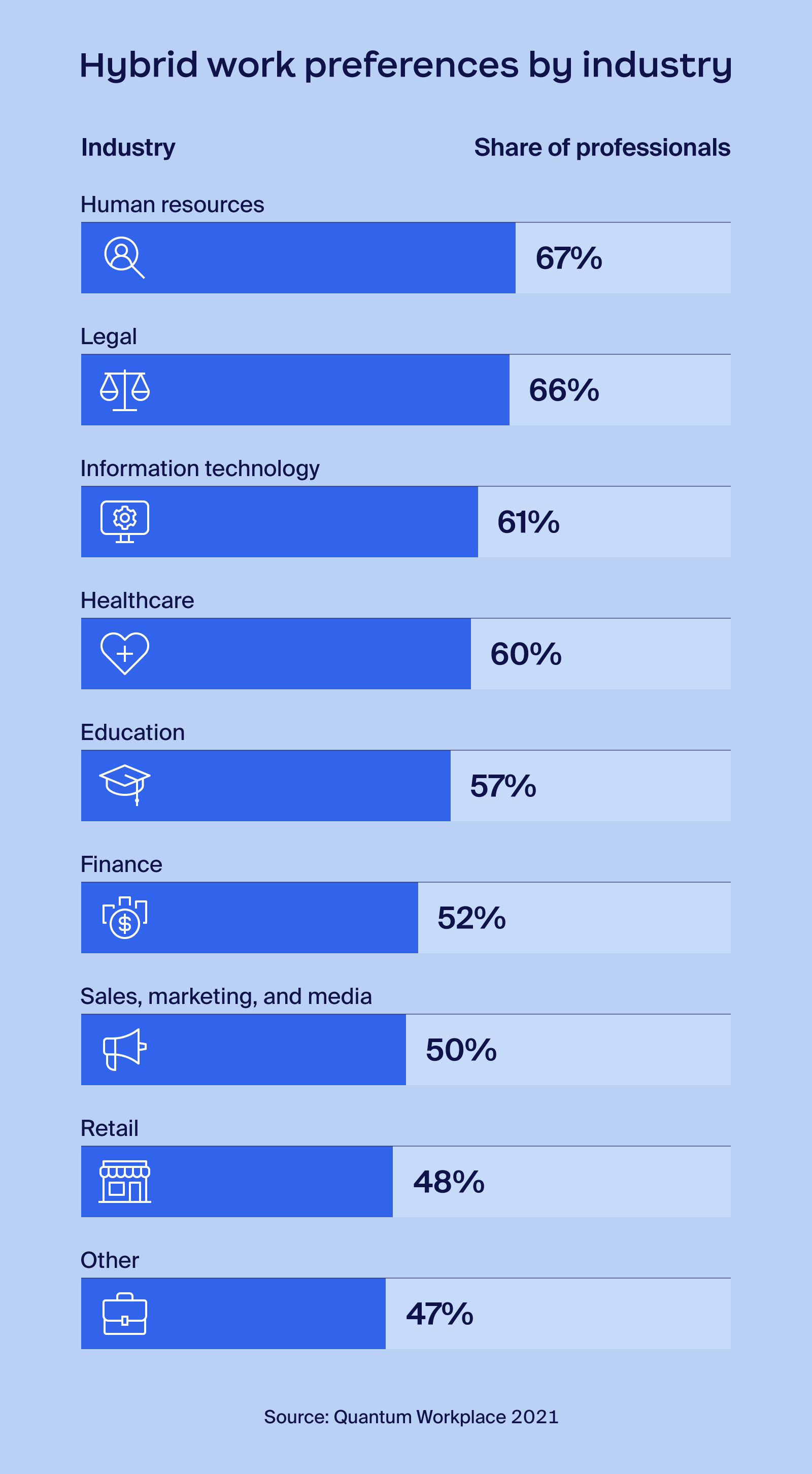
Meet Zoom AI Companion, your new AI assistant!
Boost productivity and team collaboration with Zoom AI Companion, available at no additional cost with eligible paid Zoom plans.
Updated on October 07, 2025
Published on October 07, 2025


The modern workplace demands adaptability and a healthy balance between routine and flexibility. Transitioning from traditional office setups to flexible models combining remote and in-person collaboration has become a major part of many organizations’ strategies.
While some businesses are returning to fully onsite work, flexibility is still key to building a productive, high-performing team. In fact, 60% of workers say they would look for a new job if hybrid or remote flexibility were not allowed. The following hybrid work statistics will give you an idea of the current state of things, including hybrid work in various industries, and how flexible work is still beneficial in 2025.
Hybrid work has reshaped business operations. It’s essential to understand how this changes strategic planning and long-term success. These hybrid working statistics provide valuable insights into the current state of work and its direction.
1. As of February 2024, professionals in the hybrid workforce have the highest engagement rates at 35%, followed by fully remote employees at 33% and in-office employees at 27%. (Gallup)
2. Ninety-five percent of business leaders say their organization has become more flexible over the past two years, and 82% have plans to make it more flexible over the next two years. (Zoom)
3. Eighty-three percent of male employees say the reason they go into the office full-time is because it’s required by the company. (The Flex Report)
4. In 2023, the number of hybrid workers in America reached 29%. (WFH Research)
5. Twenty-five percent of employees would prefer a “flextime hybrid” model if they were to switch employers. (Zoom)
6. Every year since 2021, those who work onsite have reported being less satisfied with work interactions than those who work hybrid or remote. (Gartner)
7. Six out of 10 employees in jobs where remote work is possible prefer a hybrid environment. A third prefer fully remote, and under 10% prefer fully onsite. (Gallup)
8. Seventy-six percent of respondents listed improved work-life balance as a top benefit of hybrid work. (Gallup)

Some industries are better equipped to support a flexible work model than others, while some are transitioning away from hybrid or remote work altogether. These statistics help paint a picture of how different industries and departments have reacted to changing workplace environments.
9. The HR sector is more likely than others to prefer the hybrid work model, followed by legal and IT. (Boundless HQ)
10. Less than 18.2% of federal government employees spent time working remotely in April 2025, down from 31.3% a year earlier. (U.S. Bureau of Labor Statistics)
11. The food services, transportation, and manufacturing industries have the lowest remote and hybrid rates due, in part, to the need for physical interaction. (American Economic Association)
12. Jobs requiring significant physical strength, like maintenance, construction, and natural resources work, had just a 3.2% rate of telework in Q1 2024. (U.S. Bureau of Labor Statistics)
13. In the first quarter of 2024, industries with high rates of telework included management and professional (37.9%) and sales and office work (24.9%). (U.S. Bureau of Labor Statistics)

The relationship between flexible work models and productivity is a hot topic, especially since a lot of business oversight has traditionally leveraged face-to-face supervision and guidance. However, using effective communication tools and collaboration software to allow flexible work models may not only support your team’s productivity but also actively improve it.
14. 90% of hybrid employees say they are just as or more productive in their current working style as they were in the office. (Owl Labs)
15. 62% of managers say their team is more productive when working hybrid or remote. (Owl Labs)
16. In 2023, 48% of hybrid and remote employees reported feeling more energized than they did a year prior. (Buffer)
17. In a poll of HSM Advisory’s Redefining Productivity webinar attendees, 61% agreed that hybrid work has had a positive effect on productivity. (MIT Sloan Management Review)
18. A study published in the journal Nature found that the 395 managers participating in a hybrid work experiment improved their view of hybrid work’s effect on productivity, from negative (-2.6%) to positive (+1%). (Nature)
The way your employees react to a work model shapes its success. For a hybrid setting to function as intended, employees must maintain a balance between flexibility and productivity. Here are some hybrid work trends showing where professionals stand on the topic:
19. Hybrid workers experience burnout symptoms 15% less frequently than their in-office counterparts. (IE Center for Health and Well-Being)
20. Twenty-two percent of hybrid and remote workers say they would expect a pay increase if they could no longer work remotely. (Owl Labs)
21. Seventy-five percent of millennials and 77% of Gen Z working from home or on a hybrid basis would look for a new job altogether if asked to go to the office full-time. (Deloitte, UK)
While the benefits of remote work for employees are well-documented, how do employers and business owners view this work arrangement? Employer concerns about flexible work became less common as it was more widely adopted, but this has changed as the shift has headed back toward onsite work for some companies.
22. Ninety percent of CEOs say that adopting a hybrid work model is a direct reason for reduced costs. (IWG)
23. Sixty-six percent of executives believe their in-office policies did not have a positive effect on the team’s productivity. (Atlassian)
24. Flexible work arrangements are offered more often for senior roles (31% of new postings in Q2 2025 were hybrid and 14% remote). Mid-level roles came in at 25% hybrid and 12% remote, and entry-level offerings were 18% hybrid and 10% remote. (Robert Half)
Recent research into the future of work, commissioned by Zoom and conducted in partnership with Reworked INSIGHTS, surveyed more than 600 IT and C-suite leaders and nearly 1,900 knowledge workers worldwide about the nature of the modern workplace. We found that in today’s workforce, hybrid is king: 64% of employees say their company currently operates on a hybrid model.
And it isn’t king just because the workforce prefers it. Our research found that most business leaders (75%) say their company will likely change the nature of its workplace by 2026. Modern organizations feel that the hybrid model strikes a unique balance between flexibility and efficiency. In fact, 84% of business leaders pushing for flexible models are driven by higher productivity, while 62% want to improve talent recruitment.
When implementing a hybrid work model, leadership needs to consider what is required to make sure it functions as the best hybrid work environment. One of the most notable elements is the technology that remote and hybrid models need to remain sustainable. Seventy-five percent of employees believe that the technology, software, and tools that their company uses need to be improved, with 72% saying that to support remote work, their company needs to invest in new technologies.
Making a flexible work model function well takes a lot of live experimentation. The trick isn’t in prepping the workplace for a rigid hybrid model — there’s no one-size-fits-all approach — it’s in designing the new model to highlight collaboration and communication as the two most important assets.
When designing your hybrid workplace strategy, your priority should be to create a framework that enhances your team’s connectivity and eliminates any distance that physical absence might create. For the hybrid model to work successfully, it’s important to leverage the right collaboration software to reimagine your company's workplace.
That’s where Zoom comes in. With AI-first capabilities, including voice calling, video meetings, team chat, and productivity tools, you can keep your team connected and collaborative.
Learn how Zoom’s collaboration tools can help you bridge the gap between solid communication and a flexible work model.